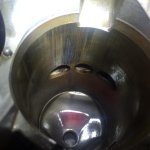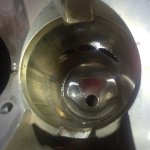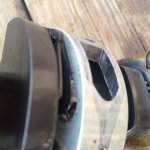Grumpy Bear
Regular Contributor
1974 Merc Thunderbolt 50hp. The #3 cylinder had no compression (pic 1) but the rings were stuck and scored when I opened it up. Had to dig them out. Noted a broken reed which probably caused this issue. The other cylinder (pic 2) had great compression but still stuck rings (1 of which I had to dig out of the groove). When I run my fingernails over the visible scores of the cylinders, there is just a slight feel of scratches detected that bump my fingernails. This is a 1974 motor...I don't want to spend a ton of money completely rebuilding it with cylinder sleeves, etc. Just want it to run this motor for a 3-4 years with a handful of uses each year. I'm planning to "hone" these cylinders to de-glaze them with a spring-mounted cylinder hone. Will de-glazing these cylinders be enough be enough in your opinion?






